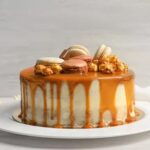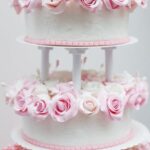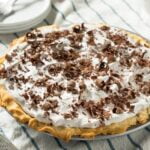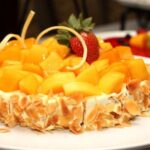Are you wondering which cream is best for cake decorating? Whether you’re a seasoned baker or just starting out, choosing the right type of cream for your cake can make all the difference in achieving that perfect finish.
There are several options to consider, each with its own unique qualities and applications. In this article, we will explore the various types of creams commonly used for cake decorating and provide tips on how to choose the best one for your needs.
When it comes to cake decorating, the type of cream used can significantly impact the final result. From buttercream to royal icing, whipped cream, and more, each type of cream offers different textures, flavors, and stability when applied to a cake. Understanding the pros and cons of each can help you make an informed decision when it comes to decorating your next masterpiece.
In addition to discussing the different types of creams available, we will also delve into factors to consider when choosing a cream for cake decorating. Factors such as taste, texture, stability, and ease of use all play a role in determining which cream is best suited for piping intricate designs or achieving smooth frosting on cakes. Whether you’re aiming for a professional-looking finish or simply want something delicious and visually appealing, choosing the right cream is essential.
Types of Cream for Cake Decorating (Buttercream, Royal Icing, Whipped Cream, Etc)
When it comes to cake decorating, choosing the right type of cream is essential to achieving the desired look and taste. There are several options to consider, each with its own unique properties and uses. Here are the most popular types of cream for cake decorating:
1. Buttercream: This creamy and easy-to-work-with frosting is made from butter, powdered sugar, and flavorings. It is a versatile option that can be used for piping, borders, and frosting cakes. The smooth texture of buttercream makes it ideal for creating intricate designs and decorations.
2. Royal Icing: Made from powdered sugar, egg whites or meringue powder, and water, royal icing dries to a hard finish, making it perfect for creating detailed decorations such as flowers and intricate designs. However, it can be quite sweet and may not be everyone’s favorite in terms of taste.
3. Whipped Cream: Light and airy, whipped cream is a delicious choice for frosting cakes but may not hold up well in warm temperatures or for intricate designs that require precise piping.
4. Fondant: While not technically a cream, fondant is a popular choice for covering cakes due to its smooth finish and ability to hold intricate shapes and designs.
Each type of cream has its own set of pros and cons that should be considered when choosing the best option for your cake decorating needs. Consider factors such as taste, texture, stability, and the specific design you are aiming to achieve.
Pros and Cons of Each Type of Cream
When it comes to cake decorating, choosing the right type of cream is essential in achieving the desired taste and aesthetic for your creations. There are several different types of creams commonly used for cake decorating, each with its own set of pros and cons.
Buttercream is a popular choice for cake decorating due to its creamy texture and ability to hold intricate designs. It can be flavored and colored in various ways, making it versatile for different cake designs. However, one downside of buttercream is that it can be quite sweet and may not hold up well in warm temperatures.
On the other hand, royal icing is known for its hard, smooth finish once dried, making it ideal for creating decorative accents on cakes. It also has a longer shelf life compared to other types of creams. However, royal icing can be quite stiff and brittle, which may not be suitable for frosting or covering an entire cake.
Whipped cream is light and airy, perfect for those who prefer a less sweet option for their cakes. It also pairs well with fresh fruits and is ideal for lighter dessert options. The downside to whipped cream is that it can lose its shape quickly if not stabilized properly, making it challenging for intricate designs or decorations.
In considering the best cream for cake decorating, factors such as taste, texture, stability, and intended design should all be taken into account to ensure the best results.
| Cream Type | Pros | Cons |
|---|---|---|
| Buttercream | Versatile; Holds designs well | Can be quite sweet; May not hold up in warm temperatures |
| Royal Icing | Hard smooth finish; Longer shelf life | Stiff and brittle; Not suitable for frosting entire cakes |
| Whipped Cream | Light and airy; Less sweet; Pairs well with fruits | Loses shape quickly if not stabilized; Challenging for intricate designs |
Factors to Consider When Choosing a Cream for Cake Decorating (Taste, Texture, Stability, Etc)
When choosing a cream for cake decorating, there are several important factors to consider in order to achieve the desired results. One of the most crucial aspects to think about is the taste of the cream. Some people prefer a rich and buttery flavor, while others may enjoy a light and fluffy texture. It’s essential to select a cream that complements the flavor of the cake itself, whether it’s a vanilla, chocolate, or fruit-flavored cake.
In addition to taste, the texture of the cream is another significant factor to take into account. Buttercream is known for its smooth and creamy texture, making it ideal for piping intricate designs onto cakes. Royal icing, on the other hand, hardens to a smooth finish which is perfect for creating elegant decorations. Whipped cream is light and airy, making it suitable for filling layers or topping off a dessert.
Stability is perhaps one of the most crucial factors when choosing a cream for cake decorating. Factors such as temperature and humidity can affect the stability of certain creams. For example, whipped cream may not hold up well in warm weather or at room temperature for extended periods of time. On the other hand, buttercream tends to be more stable and can withstand varying conditions better.
An important consideration when using different types of cream for cake decorating is their versatility in terms of use. Buttercream is excellent for piping intricate designs due to its smooth consistency and ability to hold its shape well. Royal icing works best for delicate details and creating hard decorations that need to set firmly on the cake. Whipped cream is great for frosting cakes and filling layers thanks to its light and airy texture.
| Factors | Considerations |
|---|---|
| Taste | Rich & buttery vs Light & fluffy |
| Texture | Smooth & Creamy vs Hardens Smoothly vs Light & Airy |
| Stability | Influence by temperature & humidity |
| Versatility | Piping Intricate Designs vs Delicate Details vs Frosting Cakes |
Best Cream for Piping and Intricate Designs
When it comes to cake decorating, choosing the right cream for piping and intricate designs is crucial to achieving professional-looking results. There are several types of cream that are commonly used for this purpose, each with its own set of pros and cons. Understanding the characteristics of each type of cream will help you make an informed decision on which one is best for your specific cake decorating needs.
Types of Cream for Piping and Intricate Designs:
1. Buttercream: This classic frosting is known for its smooth texture and ability to hold intricate piping designs.
2. Royal Icing: A hard, glossy icing made from egg whites and powdered sugar, perfect for delicate designs and intricate details.
3. Fondant: A thick, pliable icing that can be rolled out and draped over cakes for a flawless finish, ideal for creating detailed decorations.
Pros and Cons of Each Type of Cream:
– Buttercream: Easy to work with, but may not hold up well in warm temperatures.
– Royal Icing: Hardens quickly, making it ideal for intricate designs, but can be challenging to work with for beginners.
– Fondant: Provides a polished look and allows for extensive detailing, but may not be as tasty as other options.
Factors to Consider When Choosing a Cream for Piping and Intricate Designs:
– Taste: Some creams may taste better than others, so consider the flavor profile of each type of cream.
– Texture: The texture of the cream should be smooth enough for piping intricate designs without clogging the tip.
– Stability: Choose a cream that will hold up well in different weather conditions to ensure your decorations stay intact.
Overall, when deciding which cream is best for piping and intricate designs on cakes, it ultimately depends on personal preference and the specific needs of your project. Experimenting with different types of cream can help you determine which one works best for your cake decorating goals.
Best Cream for Frosting and Covering Cakes
Buttercream
Buttercream is a classic choice for frosting and covering cakes due to its smooth texture and ability to hold intricate designs. This type of cream is made with butter, powdered sugar, and flavorings, making it a versatile option for cake decorating. It provides a rich and creamy taste which complements a wide variety of cake flavors. However, buttercream can be quite sweet, so it may not be the best option for those who prefer less sugary desserts.
Fondant
Fondant is another popular choice for creating beautifully frosted and covered cakes. Made from sugar, water, and gelatin or glycerin, fondant offers a smooth and polished finish that can be shaped into various designs. It is also pliable and easy to work with which makes it ideal for covering large tiered cakes. However, some people find the taste of fondant too sweet or artificial, so it may not be the best choice if flavor is a top priority.
Whipped Cream
For those who prefer a lighter and less sweet option, whipped cream can be an excellent choice for frosting and covering cakes. Made from heavy cream and sugar, whipped cream has a light and airy texture that pairs well with fresh fruit or light sponge cakes. However, whipped cream can be less stable than other options, so it may not hold up as well in warm temperatures or for intricate designs that require precise piping.
When considering the best cream for frosting and covering cakes, it’s important to take into account factors such as taste preferences, stability, ease of use, and the specific design of the cake being decorated. Experimenting with different types of cream can help determine which one works best for achieving professional-looking results.
Tips for Successful Cake Decorating With Different Types of Cream
When it comes to successful cake decorating with different types of cream, there are a few key tips to keep in mind. Whether you’re using buttercream, royal icing, whipped cream, or another type of cream, these tips can help you achieve professional-looking results.
Understanding the Texture and Consistency
Each type of cream has its own unique texture and consistency, which can affect how it performs when used for cake decorating. Buttercream is known for its smooth and creamy texture, making it ideal for piping intricate designs and creating detailed decorations.
On the other hand, whipped cream is light and airy, but may not hold up as well for intricate designs. Understanding the properties of each type of cream will help you choose the best option for your specific decorating needs.
Temperature Control
Another important tip for successful cake decorating with different types of cream is to pay attention to temperature control. Buttercream and royal icing tend to perform best at room temperature, while whipped cream and other dairy-based creams require refrigeration. It’s important to consider the ambient temperature of your kitchen and the time it will take to decorate your cake when choosing a cream for decorating.
Practice and Experimentation
Finally, a key tip for achieving success with different types of cream for cake decorating is practice and experimentation. Each type of cream has its own unique characteristics and behaviors when used for decorating. By practicing with different creams and experimenting with various techniques, you can gain a better understanding of which cream is best suited for specific types of decorations on your cakes.
By keeping these tips in mind and taking into consideration the specific qualities of each type of cream, you can achieve beautiful and professional-looking results in your cake decorating endeavors.
Conclusion
In conclusion, when it comes to choosing the best cream for cake decorating, there is no one-size-fits-all answer. Each type of cream has its own pros and cons, and the best choice ultimately depends on the specific needs of your cake design.
Buttercream is a versatile option that works well for piping and intricate designs, while royal icing offers a smooth and firm surface for frosting and covering cakes. Whipped cream, on the other hand, provides a light and airy texture that can be perfect for certain types of decorations.
When making your decision, it’s important to consider factors such as taste, texture, stability, and the specific requirements of your cake design. For piping and intricate designs, a stable buttercream or royal icing may be the best choice, while whipped cream can be a great option for lighter decorations.
It’s also important to take into account the climate and conditions in which your cake will be displayed, as some creams may hold up better than others in certain environments.
In order to achieve professional-looking results with any type of cream, it’s essential to practice good technique and pay attention to detail. Keep in mind that different creams require different handling and application methods, so be sure to familiarize yourself with each type before diving into your cake decorating project. With these considerations in mind, you’ll be well-equipped to choose the best cream for your cake decorating needs and achieve impressive results every time.
Frequently Asked Questions
Which Cream Should I Use for Cake Decorating?
When it comes to cake decorating, the most commonly used cream is buttercream. Buttercream is versatile and easy to work with, making it a popular choice for frosting cakes and creating intricate designs.
What Is the Name of the Cream Used in Cake Decorating?
The name of the cream used in cake decorating is typically referred to as buttercream. This creamy and smooth icing is made with butter, powdered sugar, and flavorings like vanilla or chocolate, making it perfect for decorating all kinds of cakes.
Which Cream Is Best for Cake Topping?
The best cream for cake topping really depends on personal preference and the type of cake being served. Some popular options include whipped cream, cream cheese frosting, and ganache. Whipped cream provides a light and airy texture, while cream cheese frosting offers a tangy sweetness.
Ganache gives a decadent chocolate topping that hardens when cooled. Ultimately, the best cream for cake topping will complement the flavor of the cake itself.

Welcome to my blog about home and family. This blog is a place where I will share my thoughts, ideas, and experiences related to these important topics. I am a stay-at-home mom with two young children. I hope you enjoy reading it! and may find some helpful tips and ideas that will make your home and family life even better!





